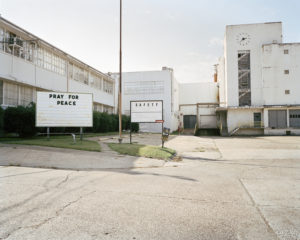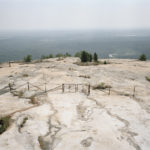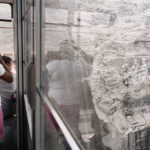Department of Art’s Assistant Professor, Jessica Ingram, Exhibits at Halsey Institute

“Law Office, Pulaski, Tennessee, 2006” from the “Road Through Midnight: A Civil rights Memorial” series by Jessica Ingram
Southbound: Photographs of and about the New South
October 19, 2018 – March 2, 2019
The Halsey Institute of Contemporary Art and the City Gallery at Waterfront Park
The Department of Art is proud to recognize Assistant Professor, Jessica Ingram, in the Halsey Institute of Contemporary Art’s latest exhibition, Southbound: Photographs of and about the New South. This exhibition attempts to convey the South within the  21st century and is built with the visions of over sixty artists.
21st century and is built with the visions of over sixty artists.
Offering a fresh perspective on a land founded upon tradition but ruled by change, the photographs echo stories of southern tradition transitioning in a new wave of Americanization and Globalization. The project’s purpose is to investigate the senses of place in the South that congeal, however fleetingly, in the spaces between the photographers’ looking, their images, and our own preexisting ideas about the region.
Born in Nashville, Tennessee and passionate about her exploration to understand communities, progress, and resistance in American culture, Ingram distinguished herself as a student, a contemporary artist, and ultimately an educator.
The galleries of the Halsey Institute and the City Gallery are open to the public and admission is free. Any changes of hours will be posted on halsey.cofc.edc and citygalleryatwaterfrontpark.com
Jessica Ingram Works
Road Through Midnight: A Civil Rights Memorial
Site of Vernon Dahmer’s Murder, Kelly Settlement, near Hattiesburg, Missippi, 2009, brings beauty to a chilling story. Vernon Dahmer was killed on January 10, 1966, when Klansmen firebombed his home and attached store. Dahmer was the president of the NAACP chapter in Hattiesburg and helped black voters by letting them pay their poll taxes at his store. Four of Dahmer’s sons were serving overseas and had protective escort from the airport when they returned. Fourteen men were arrested in the late 1960s, resulting in one conviction and several mistrials. Samuel Bowers, who served six years in prison for the murders of civil rights workers James Chaney, Andrew Goodman, and Michael Schwerner, was retried and convicted for Dahmer’s murder in 1998. Dahmer’s wife erected a memorial on the site of the house and store with bottles that were found in the wreckage.
Armstrong Tire and Rubber Company, Natchez, Mississippi, 2007 reveals an unexpectedly explosive story. On February 27, 1967, thirty-six-year-old Wharlest Jackson, the treasurer of the local NAACP chapter, was killed instantly when a bomb exploded in his truck. He had recently received a promotion to a position formerly reserved for white employees at the Armstrong Tire and Rubber Company. His son, Wharlest Jackson, Jr., heard the blast from his home nearby and rushed to the scene to find his father dead in the road. It is believed that Jackson was murdered by the Silver Dollar Group, a particularly violent Klan group who used explosives in the Natchez, Mississippi–Ferriday, Louisiana corridor. No one has been convicted of this crime. The community and family members erected a historical marker in 2011.
Throughout her different collections, Ingram’s pieces continue to tell the stories of socially charged situations in the south, while also revealing the beauty that transcended. Her pieces shed to light the struggle for southerners to find peace among each other, as well as exhibit what she finds most unique about the south.
- For the “Road Through Midnight: A Civil Rights Memorial” series, this piece was inspired by a Ku Klux Klan hate crime atop the mountain.
- Taken in Midnight, Mississippi for the “Road Through Midnight: A Civil Rights Memorial” series.
- Taken for the “Road Through Midnight: A Civil Rights Memorial” series brings to light the struggle behind finishing the monument.
- From the “Love Rich Land” series.
- From the “Road Through Midnight: A Civil Rights Memorial” series, this piece pictures the yard of the NAACP’s first field secretary of Mississippi who was murdered.






